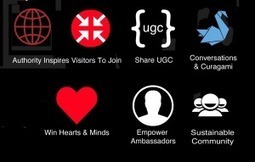5 Web Design Implications Evolution Of Web Design
Our @Curagami Evolution of Web Design Infographic (http://sco.lt/74Nvsn_ broke daily view records for our startup. Here are 5 Web Design Implications implied by that infographic:
- Leave Room For THEM (visitors & customers) - As User Generated Content (UGC) becomes increasingly important its important to build in ROOM for comments, reviews and other UGC. UGC needs an ASK and the room to curate and share results of the ask.
- One For You, 2 For Them - Every System & Process you build for YOU, build 2 for them. Can users follow each other? Can users share a profile? Can users share content ideas and content easily? What is your social reward system for content shares.
- Social Graphics - there is a reason people in the army wear rank. Wearing "social rank" immediately says who someone IS with a single graphic. Easier to trust social avatars when they are similarly grounded with graphics earned and proudly socially displayed. Social graphics reward those who've earned them AND set the stage for the next generation of people aspiring to "be like them" so a double win. Find ways to share feedback in social spaces like charities do with thermometers.
- Build an Ambassadors Area - ambassadors are so important to creating and sustaining online community. Ambassadors are volunteers wiling to sacrifice to JOIN and ADVOCATE you and your ideas. One CSF our startup Curgami is working on is how to quickly identify a website's 1% Contributors and 9% Supporters. Once identified GIVE THEM JOBS and a special place to "hang out".
- Curate & Collaborate More, Create Less = more "blank pages" - design is an important wrapper, but web design can become an obstruction too. If you curate a "Member of the Month" feature leave room to fill up as you go. Maybe this month's feature sits on top of 3 previous months. The more face-time you can build for THEM the more social shares and support your online community earns.
What about you? What design changes do you see ahead? As we move to "community" how can our design support and create trust?



 Your new post is loading...
Your new post is loading...







